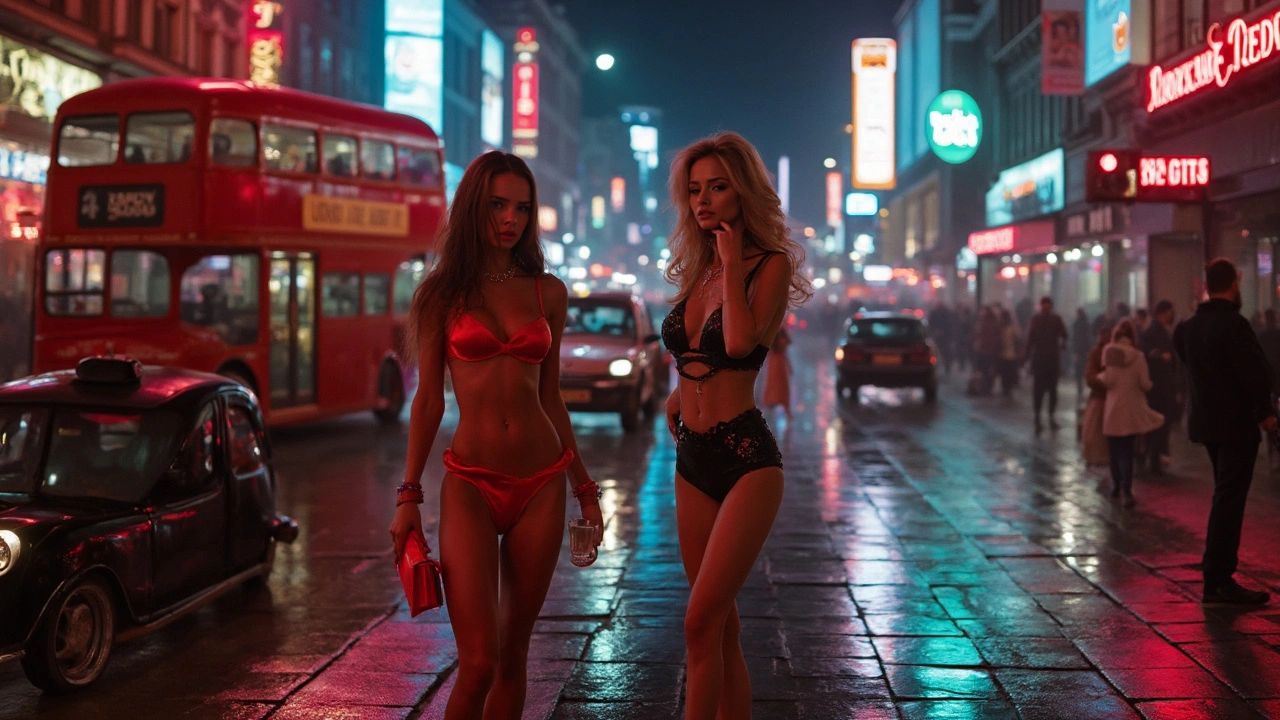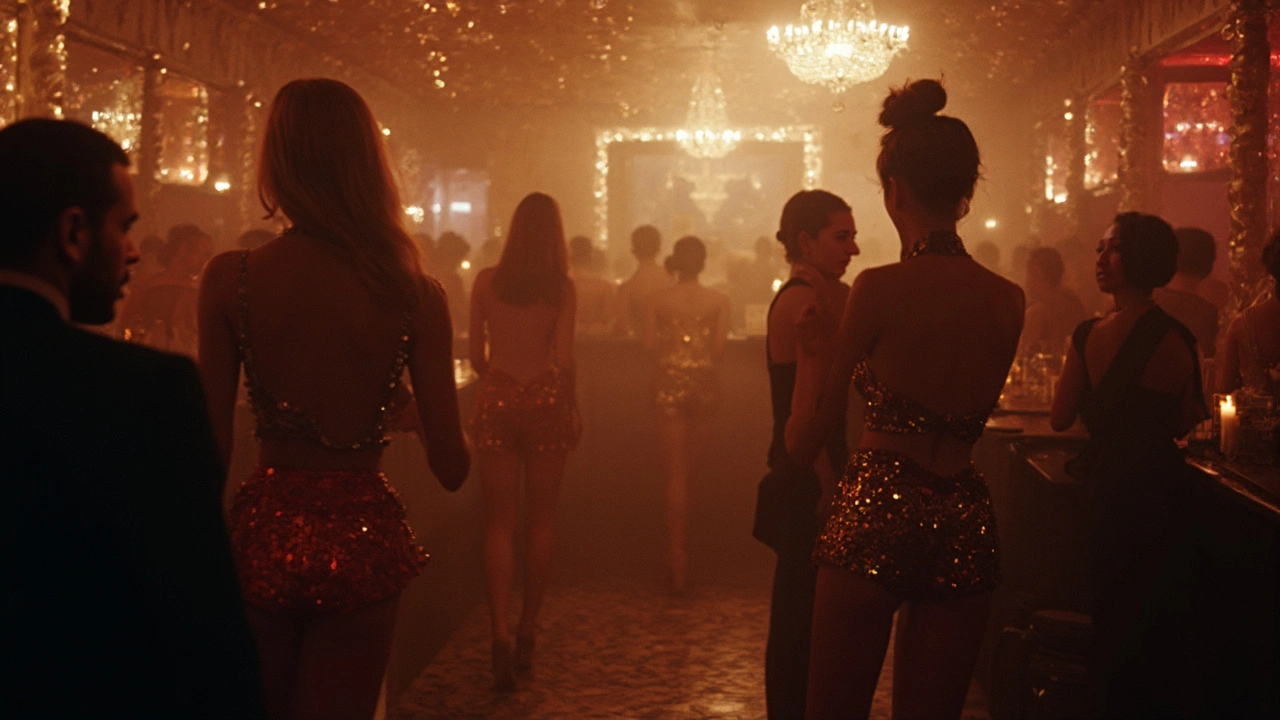London Call Girls 1980: Behind the Glamour and the Grit

The London of the 1980s was a place of color, music, and new cultural expressions—think punk, new wave, and the creation of iconic fashion statements. Among all this, the world of call girls thrived in its own parallel dimension, hidden in plain sight among the glittering streets and shadowy corners of the city.
Call girls during this era were more than just a fixture of the nightlife; they were an essential strand in the tapestry of London's electric atmosphere. Unlike today's internet-driven industry, these women operated with personal ads in magazines or discreet phone calls. Trust was built face-to-face, and word of mouth was gold.
- Setting the Scene
- Life of a Call Girl
- Clientele and Experiences
- Safety and Challenges
- Societal Perceptions
- Media Portrayal
Setting the Scene
In the early 1980s, London was a city of contrasts. While striking new subcultures were blooming, the economy was in a tight spot. Amidst it all, the nightlife never stopped buzzing. The 1980s escort scene was thriving, offering a world of allure and financially viable opportunities for those involved.
This period saw a mix of influences driving the city’s pulse. The hangover of the previous decade's free culture was still in the air, buoyed by the energetic beats of new wave and punk music. London wasn’t just a hub for finance and fashion; it was a cultural epicenter where boundaries were constantly tested.
London's Nightlife
Every night, the streets of SOHO and surrounding areas transformed into a vibrant kaleidoscope of light and sound. Clubs were opening their doors wide, each with their unique theme. From alternative scenes to posh, exclusive events, there was something for everyone. It was in these environments that London call girls mingled effortlessly with the glitterati and regular punters alike.
Call girls moved in a hidden world, expertly navigating upscale bars and private parties. The competition was fierce, but it was also community-driven; many women supported each other, sharing networks of safe clients and venues. The element of personal contact meant that establishing trust was key, leading to longstanding relationships that often blurred professional lines.
Legal Landscape
Of course, there were legal gray areas. While prostitution itself was technically legal, activities like soliciting and brothel-keeping were not. This didn't stop the trade but rather pushed it into a complex underground world where law enforcement pursued visible infractions.
This cat-and-mouse dynamic added edge to the profession. Women employed different tactics to avoid trouble, such as code words over the phone or working through trusted intermediaries to set appointments.
Life of a Call Girl
In the bustling, neon-lit streets of 1980s London, the life of a call girl was as diverse as it was secretive. These women navigated their world with a unique blend of poise, caution, and adaptability. More than just escorts, they were entrepreneurs and social chameleons, moving seamlessly among different circles.
A typical day could mean artfully handling clients from high society gatherings to intimate events with a more personal touch. Unlike today's digital methods, networking relied heavily on personal introductions and word-of-mouth reputations. Call girls had to be street-smart and socially savvy to thrive.
Work Environment and Daily Routines
Most London call girls operated out of small flats or rented spaces, with some even running operations from their own homes. The setup allowed them to maintain a degree of privacy and control. For those in the know, these were exclusive addresses where discretion was assured.
"The art of being a call girl is to give the illusion of a relationship without the reality of one," noted Maggie Holden, a historian specializing in social dynamics of the 1980s.
Many call girls kept meticulous schedules to manage regular clients and new inquiries. Evenings were often busy with multiple appointments. This lifestyle necessitated excellent time management skills, ensuring arrivals and departures played out flawlessly.
Personal Safety Measures
While there was undeniable allure in their line of work, it wasn't without risks. Safety was a top priority, and many call girls had measures to ensure their well-being. This included background checks through reliable contacts and setting up coded calls or signals with a trusted friend.
Fashion and Presentation
Presentation mattered immensely. Call girls crafted their personas with care, often reflecting current trends. It wasn't uncommon to see them in tailored suits or designer dresses, ensuring they exuded both class and charm.
The 1980s call girl in London was more than a fixture of its nightlife; she was an integral part of it, embodying the city's vibrant, edgy dynamic while navigating it with skill and subtlety.
Clientele and Experiences
Back in the 1980s, the clientele of London call girls was as diverse as the city itself. From high-flying business executives to tourists looking for a taste of the wild side, these women catered to all sorts. The common thread? The need for discretion and a touch of class.
One of the remarkable features of the era was the rise of the 'Yuppie' culture—young urban professionals with cash to burn and a penchant for luxury. This crowd often indulged in the company of call girls, seeing it as an extension of their extravagant lifestyle. Client interactions weren't just transactional; they were often like stepping into an alternate world, a brief escape from the rigid norms of everyday life.
The Regulars
Regular clients formed the bread and butter of many 1980s call girls. These relationships could be surprisingly genuine, with both parties knowing where the lines were drawn. It's not uncommon to hear stories of call girls who attended grand openings and even gala events—blending into the social fabric.
A Night to Remember
While discretion was the standard, some encounters played out like scenes from a movie. Picture this—a late-night drive through the vibrant streets of London in a classic Jaguar, ending at a rooftop overlooking the city's sparkling skyline. That's just a snippet of what some experiences entailed.
But not every experience was glamorous. The 1980s came with its own set of dangers. It was a world without GPS and mobile phones, making safety a daily concern. Despite the threats, these women navigated through with street smarts and a close-knit network that offered support and info.
Though the allure of the 1980s call girl scene often got romanticized, it was a mix of highs and lows, of memorable nights and distant realities. All that glitters isn't gold, but it sure sparkles brightly.

Safety and Challenges
Back in the 1980s, the job of a London call girl wasn't just glitz and glamour; the shadow of danger was close by. Operating in a pre-internet world, these women had to rely heavily on intuition and street smarts. Unlike today where apps can vet a client beforehand, back then, every meeting had a layer of risk.
Risky Business
To start, there was always the risk of encountering clients who had misrepresented themselves. Without online profiles to check out, descriptions were often vague and it was easy for things to go sideways. Violence, unfortunately, was not uncommon, and many carried secret alarms or had back-up plans with friends who knew their whereabouts.
The Police and Legal Hassles
Being a call girl was also legally fraught. At the time, the lines between what was permissible and what wasn't were blurred. Although being a call girl was legal, soliciting in public wasn't, and this often led to nerve-wracking encounters with law enforcement. Despite this, some officers turned a blind eye or accepted bribes, but it was always a gamble.
Health and Well-being
Health was another major concern. The AIDS epidemic was intensifying in the 1980s, making safety measures in sexual encounters critically important. Many London call girls insisted on protection and regular health check-ups, despite this not being the norm everywhere.
Community Support
On a brighter note, the era saw the beginnings of support networks. Women started organizing to share safety tips and advocate for better working conditions. These grassroots movements laid the groundwork for the more structured support systems seen today.
Despite the adversity, the resilience shown by these women was remarkable, maintaining their poise in the face of constant challenges and redefining what it meant to be a call girl in London during the 1980s.
Societal Perceptions
The role of London call girls in the 1980s was a hot topic of both gossip and fascination. At the time, society was straddling a line between conservative values and a burgeoning embrace of modernity. This meant that call girls were viewed through a lens of both scandal and intrigue.
On the one hand, a rising wave of liberal attitudes started to challenge traditional norms. London’s nightlife was expanding, and with it, there was an increasing acceptance—or at least an intrigued curiosity—about the life of call girls. People were beginning to view these women as part and parcel of the vibrant city life, akin to the bustling market scenes or emerging music clubs.
Yet, despite this fascination, many maintained a stigmatized view of the profession. The media often fed into stereotypes, painting these women in sensationalized narratives of decadence and tragedy. This, in turn, shaped public perception, leading to a dual nature of intrigue mixed with disdain.
Public vs. Private Opinions
In private, stories of opulence and adventure shared by call girls with their close circles often conflicted with societal judgements. Many knew someone who knew someone involved in the trade, and firsthand stories sometimes blurred the lines drawn by public media stories, illustrating a reality less about vice and more about varied personal agency and economic decisions.
| Year | Media Portrayal |
|---|---|
| 1980 | Scandalous and Mysterious |
| 1985 | Sensationalized Adventure |
| 1989 | Object of Intrigued Curiosity |
Ultimately, the 1980s was a time of contrasts for London’s call girls. As they became absorbed into its booming nightlife, they remained figures who both tantalized and pushed societal boundaries, forcing many to reconsider their own viewpoints on the roles women could play in metropolitan settings.
Media Portrayal
During the 1980s, the portrayal of London call girls in media was both a reflection and a manipulation of public perceptions. Television series, films, and tabloid articles often depicted them through a lens of sensationalism and intrigue, sometimes hinting at the luxurious lifestyle but also underscoring the dangers they faced.
One popular TV series from that time was 'The Professionals,' where call girls occasionally appeared as part of storylines that complicated the lives of spies and detectives. The media loved to play on the duality of glamour and risk, painting an image that was as much about fantasy as it was reality.
Impact of Films
British cinema also played a part in shaping the narrative. Movies like 'Mona Lisa' (1986), starring Bob Hoskins, delved into the murkiness surrounding these women's lives and the elements of crime and vulnerability they encountered. This film, in particular, provided a gritty yet humanizing portrayal that stood in contrast to the usual glamorous TV depictions.
Tabloid Sensation
Tabloid newspapers were notorious for their lurid headlines and scandalous stories, often exaggerating the involvement of 1980s escorts in the darker side of London life. These stories often lacked any nuanced understanding of the individuals involved, but they contributed to public understanding—or misunderstanding—of the trade.
Media portrayal was largely superficial, focusing on the salacious details rather than the complex realities these women faced daily. This portrayal has left a lasting impact on public perception, blurring lines between truth and embellishment, a trend that would only start shifting towards a more nuanced depiction decades later.